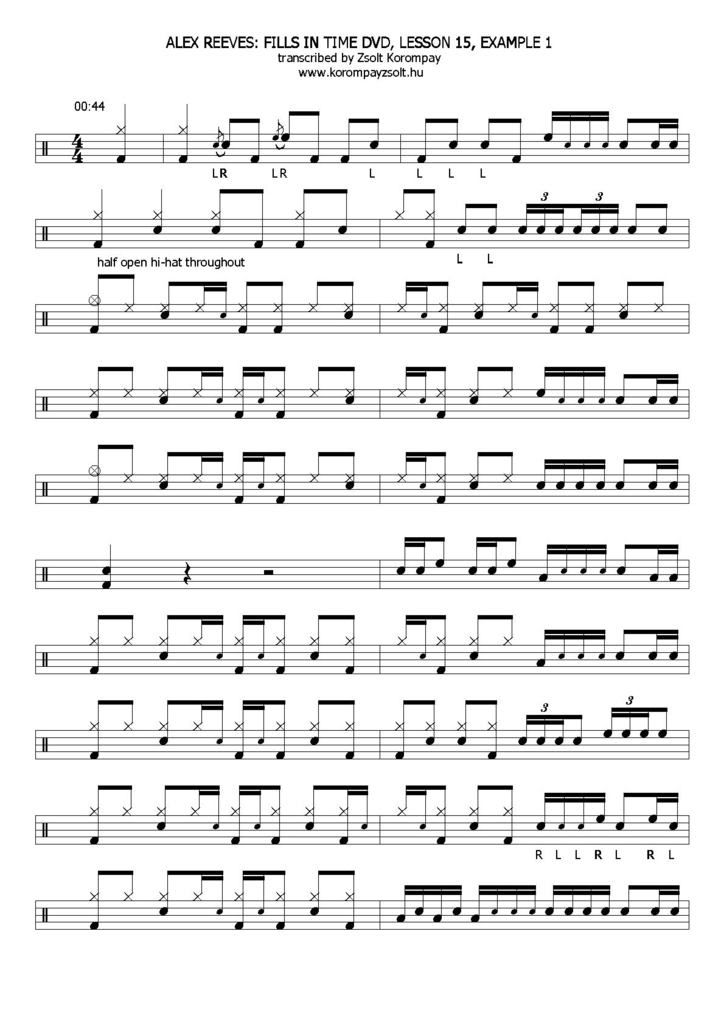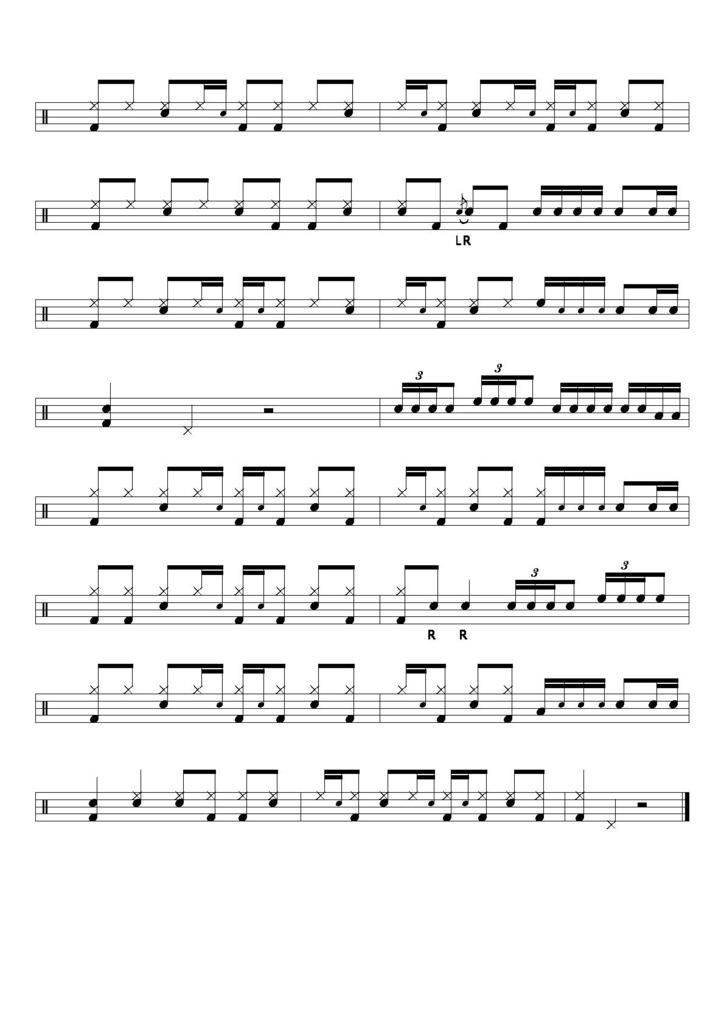You are using an out of date browser. It may not display this or other websites correctly.
You should upgrade or use an alternative browser.
You should upgrade or use an alternative browser.
fill ideas??
- Thread starter js2512
- Start date
Rockingfreakapotamus
Senior Member
use rudiments across various drums.
six stroke roll, across the toms?
five stroke roll?
the pataflafla?
the more you try, the cooler things begin to sound. Try the "less is more" approach.
six stroke roll, across the toms?
five stroke roll?
the pataflafla?
the more you try, the cooler things begin to sound. Try the "less is more" approach.
B
blink44
Guest
dont overthink it, just play what comes out.
usually when i just play on my drums i just play i barely think
usually when i just play on my drums i just play i barely think
B
blade123
Guest
Something that my teacher has showed me is 1/1 2/1 2/2 4/2. That's one on top, one on bass; two on top, one with bass, etc. Speed those up and you have a ton of fill options. Also, go simple, a press roll can work great as a fill.
foursticks
Pioneer Member
Listening to music will give you plenty of ideas and practising your rudiments and stickings will give you the ability to translate what's in your head onto the kit.
Tryitagain
Member
dont overthink it, just play what comes out.
usually when i just play on my drums i just play i barely think
I'll second that...
I (almost) never practice specific fills. I do spend time just moving around the drumset along with a metronome. Over time your brain will weed out what sounds stupid and retain what sounds good. I believe good fills come from the heart, not from a textbook.
Of course this goes along with practicing rudiments as mentioned above, along with everything else ... it's all part of a balanced breakfast of delicious drumming!
groovemaster_flex
Silver Member
I like to get some good ol' hand-feet coordination going on when I do fills.
The classic triplets between hands and feet is a good one.
RLF RLF RLF RLF.
You could always mix it up a bit, play groups of 5 in 4/4 time, those always sound cool.
RLRL FRLR LFRL RLFR LRLF RLRL CRAAAAAAASSSSSSSSHHHHHH!!!!!!!!!*
R standing for right, L for left, and F for foot. As in foot on bass drum pedal
My personal favourite is switching up between double strokes and single strokes.
Perfect example, Jeremy Taggart does the fill after the breakdown in Starseed.
Rabbada babbada babada babada *guiiitarrr riff* That fill was probably recorded seperately from the rest of the track, lol. I spent so long trying to figure out how to play it XD I'll post a video if I get the chance.
The classic triplets between hands and feet is a good one.
RLF RLF RLF RLF.
You could always mix it up a bit, play groups of 5 in 4/4 time, those always sound cool.
RLRL FRLR LFRL RLFR LRLF RLRL CRAAAAAAASSSSSSSSHHHHHH!!!!!!!!!*
R standing for right, L for left, and F for foot. As in foot on bass drum pedal
My personal favourite is switching up between double strokes and single strokes.
Perfect example, Jeremy Taggart does the fill after the breakdown in Starseed.
Rabbada babbada babada babada *guiiitarrr riff* That fill was probably recorded seperately from the rest of the track, lol. I spent so long trying to figure out how to play it XD I'll post a video if I get the chance.
slingerland755
Silver Member
Get your flam accents together and move them around the drums. I think this rudiment is very powerful and sounds really complicated and interesting to the listener.
http://www.alexreeves.co.uk/
http://www.youtube.com/watch?v=OcZCZzpcjy4
http://www.youtube.com/watch?v=VyT_oncW8O8
http://www.joecrabtree.com/home.html
http://www.youtube.com/watch?v=PCNI8Yyy6mQ
http://www.youtube.com/watch?v=-CCMhTaM3GA
http://www.youtube.com/watch?v=dRHc1leQamM
http://www.youtube.com/watch?v=Rnoj_cQqe94
http://www.youtube.com/watch?v=we50BWeNllg
http://www.youtube.com/watch?v=UBosYTfpSn4
http://www.youtube.com/watch?v=Bat9k3MNXY0
http://www.youtube.com/watch?v=TXXwXWOxouQ
http://www.youtube.com/watch?v=74QfCsZQOpE
http://www.youtube.com/watch?v=hNBT5BQwdGQ
http://www.youtube.com/watch?v=pmK85ZpY254
http://www.youtube.com/watch?v=idsP_Hu5AeI
http://www.youtube.com/watch?v=nDaKMeyMUmE
Check out the last post here: http://www.drummerworld.com/forums/showthread.php?t=23405&page=2
I hope that's enough for now... Good luck!
http://www.youtube.com/watch?v=OcZCZzpcjy4
http://www.youtube.com/watch?v=VyT_oncW8O8
http://www.joecrabtree.com/home.html
http://www.youtube.com/watch?v=PCNI8Yyy6mQ
http://www.youtube.com/watch?v=-CCMhTaM3GA
http://www.youtube.com/watch?v=dRHc1leQamM
http://www.youtube.com/watch?v=Rnoj_cQqe94
http://www.youtube.com/watch?v=we50BWeNllg
http://www.youtube.com/watch?v=UBosYTfpSn4
http://www.youtube.com/watch?v=Bat9k3MNXY0
http://www.youtube.com/watch?v=TXXwXWOxouQ
http://www.youtube.com/watch?v=74QfCsZQOpE
http://www.youtube.com/watch?v=hNBT5BQwdGQ
http://www.youtube.com/watch?v=pmK85ZpY254
http://www.youtube.com/watch?v=idsP_Hu5AeI
http://www.youtube.com/watch?v=nDaKMeyMUmE
Check out the last post here: http://www.drummerworld.com/forums/showthread.php?t=23405&page=2
I hope that's enough for now... Good luck!
Last edited:
http://www.drummerworld.com/Videos/patpetrillosextuplet.html
http://www.drummerworld.com/Videos/patpetrillosplit16.html
http://www.drummerworld.com/Videos/patpetrilloopensolo.html
There are lots of others from Pat Petrillo's "Hands, Grooves, & Fills" Book/DVD, and they really helped my phrasing tremendously. He also does simple 8th/16th note fill in orchestrations as well..I highly recommend it.
J
http://www.drummerworld.com/Videos/patpetrillosplit16.html
http://www.drummerworld.com/Videos/patpetrilloopensolo.html
There are lots of others from Pat Petrillo's "Hands, Grooves, & Fills" Book/DVD, and they really helped my phrasing tremendously. He also does simple 8th/16th note fill in orchestrations as well..I highly recommend it.
J
Wavelength
Platinum Member
Listening to music will give you plenty of ideas.
I can't believe that this advice wasn't in the first reply. Listening to music and taking influences from the real deal is the BEST (and the most obvious) way to get new ideas.
beatsMcGee
Pioneer Member
just do some seraching on you tube under Gospel Chops.. that will give you a lot of cool sounding fills
slingerland755
Silver Member
http://www.alexreeves.co.uk/
http://www.youtube.com/watch?v=OcZCZzpcjy4
http://www.youtube.com/watch?v=VyT_oncW8O8
http://www.joecrabtree.com/home.html
http://www.youtube.com/watch?v=PCNI8Yyy6mQ
http://www.youtube.com/watch?v=-CCMhTaM3GA
http://www.youtube.com/watch?v=dRHc1leQamM
http://www.youtube.com/watch?v=Rnoj_cQqe94
http://www.youtube.com/watch?v=we50BWeNllg
http://www.youtube.com/watch?v=UBosYTfpSn4
http://www.youtube.com/watch?v=Bat9k3MNXY0
http://www.youtube.com/watch?v=TXXwXWOxouQ
http://www.youtube.com/watch?v=74QfCsZQOpE
http://www.youtube.com/watch?v=hNBT5BQwdGQ
http://www.youtube.com/watch?v=pmK85ZpY254
http://www.youtube.com/watch?v=idsP_Hu5AeI
http://www.youtube.com/watch?v=nDaKMeyMUmE
Check out the last post here: http://www.drummerworld.com/forums/showthread.php?t=23405&page=2
I hope that's enough for now... Good luck!
Those are great. Should keep many a drummer busy for a while.
No fancy licks, or quadruple paradiddle-diddles played over a multiple layered foot ostinato here, "just" good straightforvard beats and fills for everyday use, played really well. http://www.alexreeves.co.uk/
http://www.youtube.com/watch?v=KjPq7NNy0Bo


http://www.youtube.com/watch?v=KjPq7NNy0Bo


I think probably the first thing to do and keep doing is just listening to music. And not just one genre. With different types of music come different styles and different fills and they can all sound great together so just listen to a wide variety of music.
Aside from that it's first about feeling the music and letting it come from the soul when you play. Once you get into it, it'll all flow out naturally and you wont even really know what your playing but it'll work. And of course just practice rudiments: singles, doubles, rolls, flams, ruffs, paradiddles, 3-stroke patterns, foot/stick patterns and whatever else you can think of. Also incorporate different stick techniques: rim clicks, rim shots, stick shots, etc. in adition to your patterns.
And another thing I love doing is just mixing up the groove for a fill every now and then. Sometimes fills don't need to go all over the set; you can stay right where you are just funk up the groove up for your fills. People love it when drummers break down the groove into something funky.
Aside from that it's first about feeling the music and letting it come from the soul when you play. Once you get into it, it'll all flow out naturally and you wont even really know what your playing but it'll work. And of course just practice rudiments: singles, doubles, rolls, flams, ruffs, paradiddles, 3-stroke patterns, foot/stick patterns and whatever else you can think of. Also incorporate different stick techniques: rim clicks, rim shots, stick shots, etc. in adition to your patterns.
And another thing I love doing is just mixing up the groove for a fill every now and then. Sometimes fills don't need to go all over the set; you can stay right where you are just funk up the groove up for your fills. People love it when drummers break down the groove into something funky.
Not always, but sometimes for funs sake, I like to get a piece of paper and just start writing sticking patterns without thinking, like R-right hand, L-left hand, K-kick. You write until you get to a certain number, depending on what kind of fill you want to go for. If you are playing in a standard 4/4 time and you want a straight 32nd fill for the whole measure, you will write 32 different R's, L's, or K's. If you are playing in 5 and you want a full measure of 1/8 triplets you write 15 different different ones, or double it to play 16th not triplets.....and so on. After you have something down, learn it slow on one drum and your kick. After you get it down, try adding some accidents in places that are do-able, and try moving around the kit a few different places. These type of things can also turn into pretty cool linear grooves.
Here are a couple of examples.
4 counts of 16ths / 2 counts of 32nds - RLLRRLKKRKKRLKRL
5 counts of triplets - RKKRLRRKLRKKLRL
Kinda get the idea?
Here are a couple of examples.
4 counts of 16ths / 2 counts of 32nds - RLLRRLKKRKKRLKRL
5 counts of triplets - RKKRLRRKLRKKLRL
Kinda get the idea?
BWT hooligan
Junior Member
dont overthink it, just play what comes out.
usually when i just play on my drums i just play i barely think
That is partially true. However, it all depends on your overall level and experience.
Personally i listen to a huge variety of types of music and whenever i hear something interesting and challenging i learn to play it. Over the time the more you learn somebody else's fills and licks you find yourself much more competent in expressing your own rhythmic ideas.
Basically, pay attention to pros and just learn what they do.
One more thing. You might want to get some kind of program or device that slows down the audio, because if you will be learning complex fills without seeing the video with it you may find difficult to figure out what is actually happening.
Howdy, I'm new here but I found this thread interesting, I like to fill according to the song. If it is grandiose than I will try and fill accordingly. I listen to what the song is saying, If it's an old country standard than there is no fill needed, but if it is updated there might be a need for some suspense, It really comes down to what the song is telling you. A lot can be accomplished without playing what might be expected. N
chimpy3
Member
I have been searching for such a program, as many videos on the internet are just to fast to work out the stickings. Can you name some examples of this type of software?One more thing. You might want to get some kind of program or device that slows down the audio, because if you will be learning complex fills without seeing the video with it you may find difficult to figure out what is actually happening.
chimpy
BWT hooligan
Junior Member
i am going to find out about the video.
What i use is an Olympus digital recorder, on which i could put a part of the song i like and then slow it down as much as it gets so that i hear the actual strokes being played. Then i gradually speed it up until i can play it within the original tempo.
I learned a few cool fills from Tool's drummer Danny Carey this way, among other things.
So the video is a good thing to use, but if you have just the audio it may be good enough.
What i use is an Olympus digital recorder, on which i could put a part of the song i like and then slow it down as much as it gets so that i hear the actual strokes being played. Then i gradually speed it up until i can play it within the original tempo.
I learned a few cool fills from Tool's drummer Danny Carey this way, among other things.
So the video is a good thing to use, but if you have just the audio it may be good enough.

